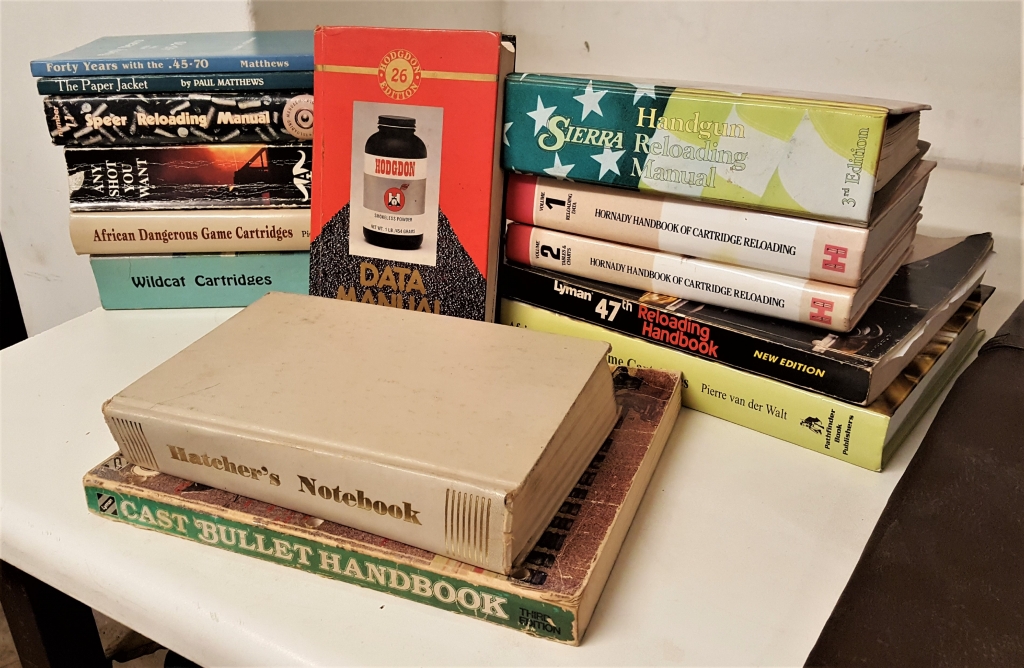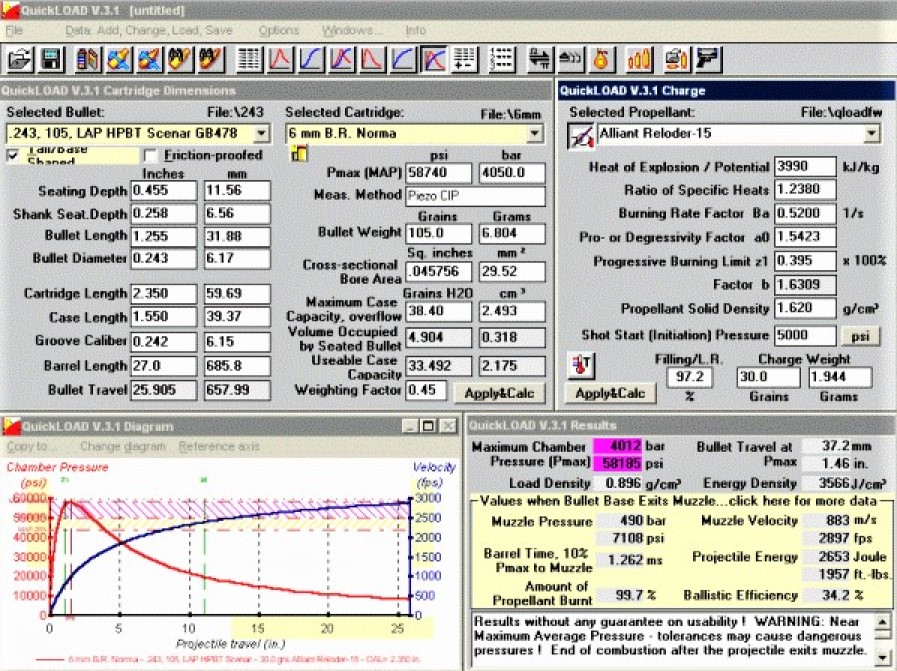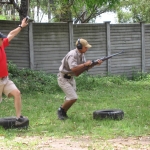In the beginning, there was the ballistic pendulum, invented by Benjamin Robins back in the 18th century. The pendulum, which deflects a given distance when struck by a projectile, is intended to measure the momentum of a bullet. If you divide the bullet’s momentum by its mass, you have its velocity. And lest anyone think this concept is a relic of two centuries ago, the ballistic pendulum was used in the 1970s and into the 1980s to gauge the power factors for International Practical Pistol Confederation practical pistol matches.
The ballistic pendulum was followed shortly after Robins’ death by Alessandro Vittorio Papacino d’Antoni’s wheel chronometer. Imagine a rotating cylinder with paper extending vertically from the rim. A bullet is fired across the diameter which penetrates the paper on opposing sides. Knowing the diameter of the cylinder and the speed of the cylinder’s rotation, the shooter can calculate the bullet’s velocity using the angular difference between the two bullet holes. At the beginning of the 19th century, the Frenchman Colonel Grobert improved on the design by using an axle (which was basically d’Antoni’s cylinder on its horizontal axis) and lengthened to just under 4m. Again, target cards at right angles to the axis, one either end, were shot by a projectile and the angular deflection in the points of impact, together with the speed of rotation and the distance between the cards was used to determine the bullet’s velocity.
The first ballistic chornograph as we know it was developed by the Reverend Francis Bashforth in Britain in 1865. He set up ten aligned screens, consisting of threads which conducted an electrical current. As the bullet passed through each screen in turn, it broke threads which in turn briefly disrupted the current, allowing the projectile’s speed to be not only calculated but recorded on a paper graph.
Like so many other things in our daily lives that we’re probably not even aware of, we owe the modern chronograph to the space program. Kiryako Arvanetakis, a consulting engineer with the forerunner of NASA, devised a 20th century version of Bashforth’s device, whereby a bullet would break through one of two aligned copper screens which initiated the charging of a capacitor at a known rate. When the projectile hit the second screen it stopped the charging. The velocity could be calculated from the accumulated voltage. Most of today’s chronographs use optical screens which measure the speed of a projectile over a given distance; many are so compact and affordable that today’s shooter has no reason not to carry one in a well-stocked range bag.
Until fairly recently, these optical chronographs were probably most commonly represented on sport shooting ranges by the various models from Competitive Edge Dynamics, as typified by their M2. (In most of the IPSC matches I have competed in, two CEDs are set up in line to give a confirmation of results.)

A few years ago, I went to visit the late Dr Don Heath who was the R&D manager for Norma Ammunition in Sweden, and even though they had built-in state-of-the-art chronographs in their test ranges, Don had just taken delivery of a new CED M2.
Designed to work with a wide variety of pistol and rifle ammunition, the CED M2’s operating range is from 50 feet per second to 7,000fps, and the microprocessor is capable of storing over 1,000 test velocities. The functionality of earlier optical chronographs deteriorated under low light conditions, and the modern CEDs can give accurate readings at much lower light levels. The CED M2’s sensors are dual screen, but for earlier, less sensitive, models there was even a built-in LED light source incorporated into the sun-diffuser screens.
The CED M2 has a calculator-style keypad, and as a concession to IPSC incorporates a one-touch “high-average” feature which automatically averages the three highest readings in a string of shots; that works pretty well for most folks’ applications even outside of IPSC. A USB interface makes it east to connect your chronograph to your PC. I have never shot a chronograph with a .470 NE, or shot two in one day, as I have seen done, but it is also nice to have the microprocessor and display unit – which operates with a conventional 9v battery – on the bench, instead of attached to the screens.
I find, though, that the CED M2 is just a little on the bulky side to cart around in a range bag, and mine stays at the club.
Although the CED M2 may be one of the most identifiable chronographs on the market, all optical chronographs are beset by variables in ambient lighting conditions, so it was a matter of time before someone would explore new avenues of technology for determining a projectile’s velocity, and one of the first examples I saw of this was the SuperChrono, which a mutual friend got from South Africa’s premier reloading guru Pierre van der Walt on a visit down south not long ago.
Introduced by Steinert Sensing Systems, the SuperChrono’s microprocessor technology was designed to take away variables caused by fluctuations in ambient lighting conditions by measuring the bullet’s supersonic shockwave.

The SuperChrono, operating off of conventional AA batteries, offers the shooter a much larger target area (130cm x 80cm) for shot placement, which also means that velocities can be measured from close to the muzzle or from various points downrange which is not possible with an optical chronograph. The device’s display is angled at 15 degrees, so if it is placed ten feet in front of the muzzle, and a foot or so below, it is possible to read the results without leaving the shooting bench.
As with optical chronographs, setup is important. The closer the bullet’s path is to the axis of the SuperChrono, the more accurate the reading will be, and there is a built-in sighting device whereby the chronograph itself can be “aimed” at the same target the shooter is aiming at, and this is especially important when placing the unit further downrange. This is also where the larger target area comes in handy. As long as the shooter does his or her part, the SuperChrono gives good, accurate velocity measurements.
The SuperChrono is simplicity itself. There are no sun screens, no cables, no optical sensors, just a compact unit in a rugged, padded case. There is no menu, just an on/off switch and six function keys that cover all the applications you will need. You will need a tripod, but that will – literally – be a small price to pay for a versatile and accurate chronograph. You won’t even notice it in your range bag it’s so lightweight and compact.
So, what’s the catch? Well, firstly, the words “supersonic shockwave”. The velocity of the bullet you’re trying to chronograph must be supersonic, so some of the slower-moving calibres won’t register. This is not as big a deal-breaker as the advisory on Steinert’s website – http://www.steinertsensingsystems.com/product-details/superchrono-acoustic-shooting-chronograph/ – that the model of SuperChrono which I tested is no longer available. On the bright side, look forward to an upgraded, wireless model with iOS/Android apps coming in the hopefully near future.
Perhaps the most innovative chronograph I included in my evaluation was the Canadian LabRadar, which is a true departure from the age of the optical chronograph, making use of Doppler radar technology, as used in traffic speed radar devices. A good friend, Kevin Maurer, who is a past Zimbabwe IPSC national champion in Standard Division, and more recently New Zealand national champion in Classic Division, recently came back to Zimbabwe for a visit, and when he asked if my small group of shooting friends wanted anything, Chris Pakenham – who runs training courses and the national shooting proficiency examination for professional hunters and guides – said one word: “LabRadar”.

As with the CED M2, it will measure the velocity of just about any projectile you care to test – bullets, shotgun slugs, pellet guns, arrows, and even paintballs. And like the SuperChrono, it is basically a single unit, sans cables and the other traditional chronograph accoutrements that make setting up on the range a hassle. Also like the SuperChrono, it enables the shooter to check velocities at various points downrange. And you don’t have to wait for the iOS/Android app, which is already here.
Setting up the LabRadar device requires the shooter to have a tripod which will elevate the unit to muzzle height, and that’s about it. LabRadar gives accurate readings up to 100 yards, and its computer compiles statistics like minimum, maximum and average velocities within strings and for the more technically-minded, extreme spread and standard deviation. It is unaffected by ambient lighting conditions and even though it has a good internal memory, it also supports SD cards. All you have to do is place it next to the shooter, facing downrange toward the target.
It isn’t small and compact, like the SuperChrono, but for its accuracy, myriad features and ease of operation, it’s well worth keeping one at the range or even carrying it back and forth.
I tested the new supersonic and radar technology against the tried and true CED optical chronograph. Over the course of a few days we fired cartridges ranging from .223 all the way up to .500NE. I am in the process of building up a new 1911 Frankengun in .45ACP and wanted to test a number of loads using Somchem’s S121, MP200 and MS200, and I settled on the MP200 for a comparative test of the two chronographs which gave readings on subsonic velocities.
I had expected a similarity, obviously, but what I had not expected was the average reading for a string fired past the LabRadar and a string fired over the CED to be within 3 feet per second! My load was 5.8gr of MP200 beneath a 230gr Frontier CMJ bullet. I used Remington number 21/2 large pistol primers, and I did not use a progressive press to build the test loads, but rather weighed each charge on a Hornady Lock-N-Load electronic powder dispenser. Ambient temperature during the tests was 27oC. Each string had a slightly wider point spread than the average between the two machines.
My personal evaluation of the three chronographs, based on a high score of five stars, would look something like this:
| CHRONOGRAPH | MODE OF OPERATION | EASE OF SETUP AND USE | USEFUL FEATURES |
| CED MILLENNIUM | AMBIENT LIGHT | *** | **** |
| SUPERCHRONO | SUPERSONIC SHOCK WAVE | ***** | *** |
| LABRADAR | DOPPLER RADAR | ***** | ***** |
And finally, a word about load development, so you have something to chronograph.

We all hopefully subscribe to the “make haste slowly” school of thought when working up new loads, as was put across by each and every reloading manual that influenced our formative years. Err on the side of caution, choose the correct powder and start at the very bottom of the load charts, working your way up in increments until you achieve the desired performance within acceptable safety parameters. These guidelines will never be out of date. Back in the day, we had books and manuals aplenty, and now we have online electronic resources as well.

One of the best I have found is QuickLOAD, which, given a series of inputs about the cartridge, bullet, barrel length, and propellant, makes uncannily accurate projections of bullet performance, including muzzle velocity and chamber pressure. The program’s default database includes over 2,500 commercially available bullets and more than 225 powders comprising some 1,200 cartridges.
In addition to the default database, QuickLOAD is reliant on knowing the internal volume of the cartridges being loaded, which is a significant variable between manufacturers. 1cm3 of water having a weight of 1g, this parameter is determined by filling a once-fired case with water and determining the volume by weight. This can be done on any good reloading scale, and is accurate to around 0.01 cm3. The results can be averaged by repeating the process with several cases.
In the end, QuickLOAD is only an internal ballistics computer simulation, though it can provide valuable insight into the effects of changes in bullet seating depth, ambient temperature, and factors like barrel length. You should still consult other sources in developing a load, not just plug in QuickLOAD’s projections and go, but it is a very useful tool for arriving at a starting point. It can be used with a sister program, QuickTARGET, to predict external ballistic performance with a given load. What has impressed me, personally, about these programs is how accurately they have predicted the bullet’s actual performance on many more occasions than not.



Leave a Reply
Want to join the discussion?Feel free to contribute!